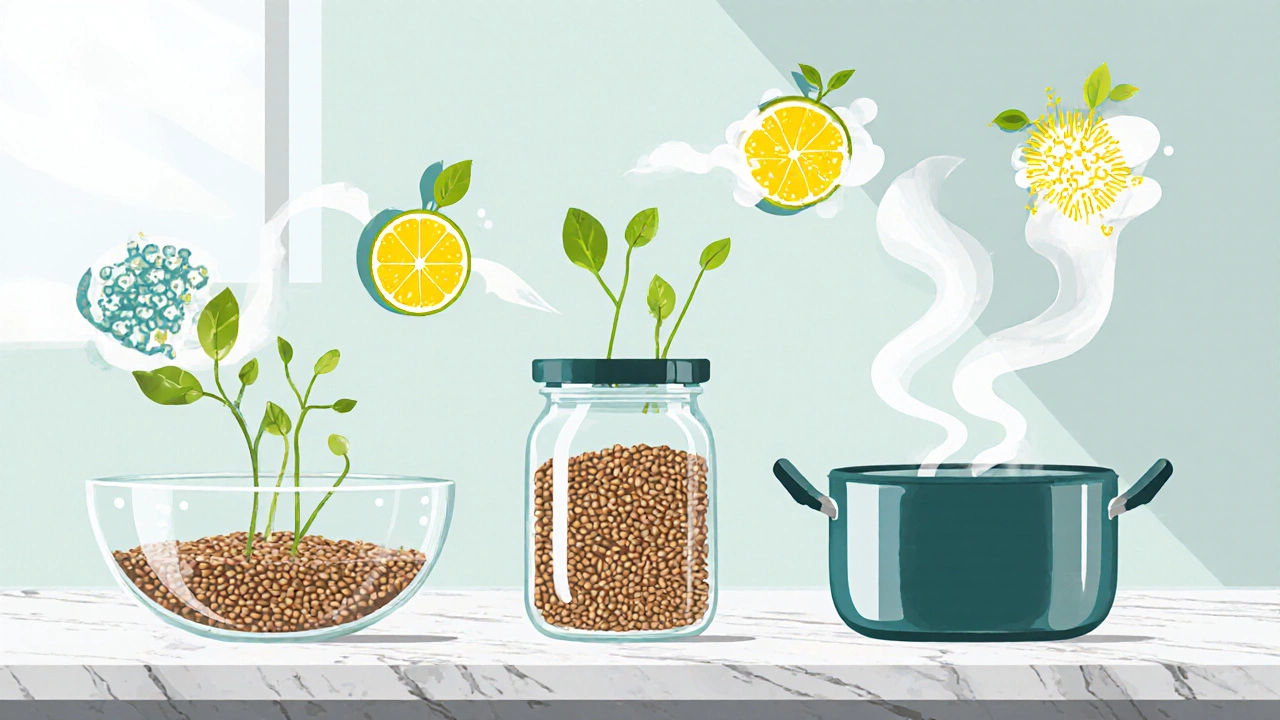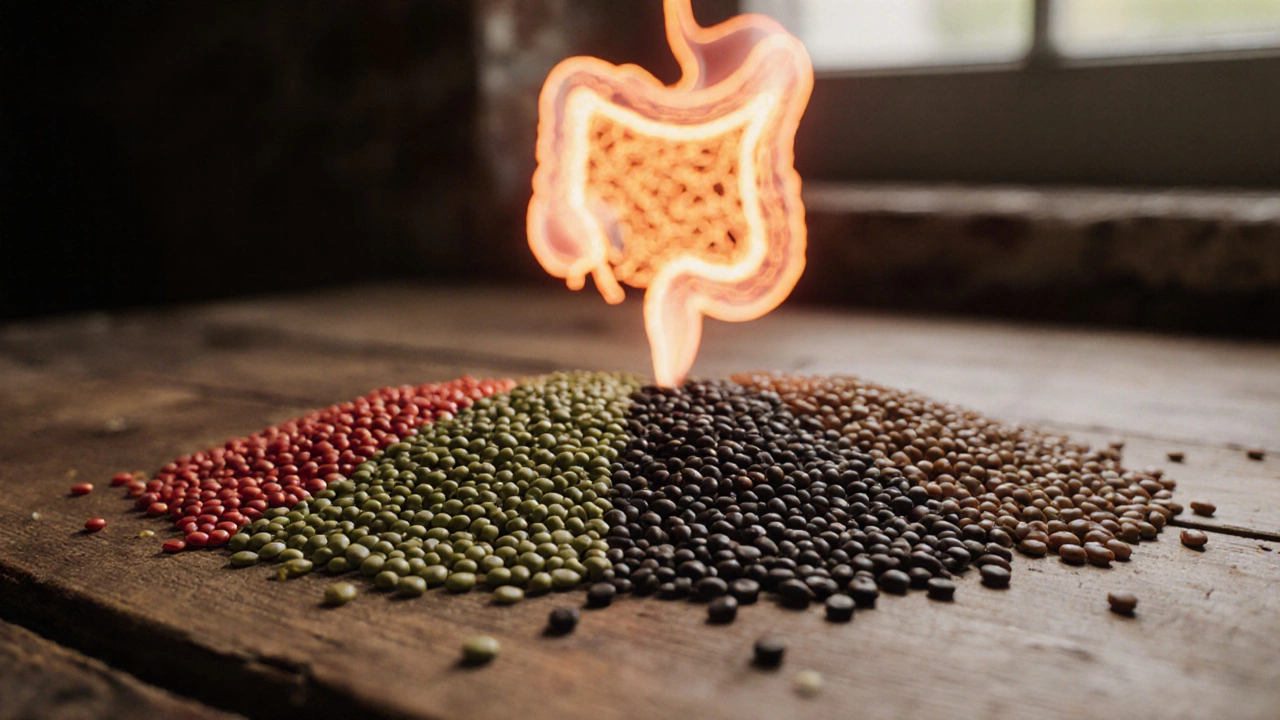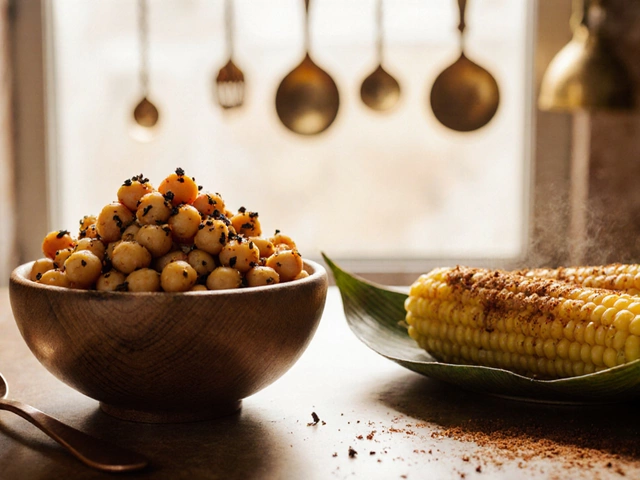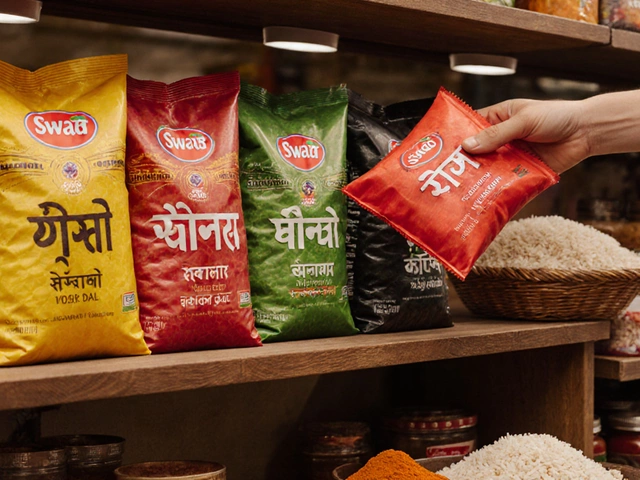Lentil Gut Health Calculator
Discover how much lentil you need daily for optimal gut health! Enter your details below.
Your Gut Health Recommendations
Daily Lentil Amount
0 g
(About 0 cups)Fiber Contribution
0 g
(0% of daily needs)Nutritional Highlights
- Protein Content 0 g
- Resistant Starch 0 g
- Iron Content 0 mg
Tip: Combine with vitamin C-rich foods like citrus or bell peppers for better iron absorption!
Lentil Nutritional Comparison
| Type | Fiber (g/100g) | Protein (g/100g) | Cooking Time | Prebiotic Value |
|---|---|---|---|---|
| Red Lentils | 8 g | 9 g | 10-12 min | High |
| Green Lentils | 10 g | 9.5 g | 20-25 min | Very High |
| Black Lentils | 11 g | 10 g | 25-30 min | Very High |
| Brown Lentils | 9 g | 8.5 g | 15-20 min | High |
Quick Takeaways
- Lentils are a natural source of both soluble and insoluble fiber, which feed good gut bacteria.
- Red, green, and black lentils differ in protein, fiber, and cooking time, letting you pick the best for your routine.
- Soaking or sprouting lentils reduces anti‑nutrients and makes nutrients easier to absorb.
- Consuming ½cup of cooked lentils daily supports regularity, reduces bloating, and may lower inflammation.
- Pair lentils with vitamin‑C‑rich foods to boost iron absorption, a key factor for overall gut health.
What Are Lentils?
When you hear “clean your gut,” you might picture a detox tea or a fancy supplement. But a humble pantry staple-Lentils a small legume packed with protein, fiber, and micronutrients-can do a lot of the heavy lifting.
Lentils belong to the legume family. They have been cultivated for over 8,000years, first in the Fertile Crescent and later across the Indian subcontinent. Today, the world produces more than 5million metric tons annually, making them one of the most accessible plant proteins.
How Lentils Talk to Your Gut
The gut isn’t just a tube; it’s an ecosystem called the gut microbiome the community of trillions of bacteria, fungi, and viruses living in the digestive tract. A balanced microbiome helps digest food, produce vitamins, and keep the immune system in check.
Lentils contain two kinds of fiber that act as food for these microbes:
- Soluble fiber dissolves in water, forming a gel that slows glucose absorption-found mainly in the seed coat.
- Insoluble fiber adds bulk and speeds up intestinal transit-present in the cotyledon.
Both types act as prebiotics non‑digestible food components that stimulate growth of beneficial bacteria. In studies from the American Journal of Clinical Nutrition (2022), participants who ate 100g of cooked lentils daily showed a 20% increase in Bifidobacterium counts after four weeks.

Nutrient Profile That Supports Digestion
Beyond fiber, lentils bring a suite of nutrients that keep the gut lining happy:
- Protein about 25% of lentil’s dry weight, providing essential amino acids-important for repairing the intestinal mucosa.
- Iron a mineral essential for oxygen transport; lentils supply non‑heme iron that’s better absorbed when paired with vitaminC.
- Resistant starch a type of starch that escapes digestion in the small intestine and ferments in the colon, feeding microbes-especially abundant in cooled, cooked lentils.
- Phytates anti‑nutrients that bind minerals; soaking reduces their level, making iron and zinc more bioavailable.
All these components work together to promote regular bowel movements, reduce gas, and lower low‑grade inflammation often linked to gut‑related disorders.
Cooking Tips for Maximum Gut Benefits
How you prepare lentils matters. Here are three tried‑and‑true tricks:
- Soak before cooking - rinse, then soak for 6-8hours in warm water. This cuts cooking time by up to 30% and lowers phytates.
- Sprout when possible - after soaking, drain and leave in a jar for 12-24hours, rinsing twice daily. Sprouted lentils boost vitaminC and reduce lectins.
- Cool before refrigerating - let cooked lentils reach room temperature, then chill for a few hours. The cooling process increases resistant starch, turning your leftovers into a prebiotic powerhouse.
Adding a splash of lemon juice or a handful of tomatoes at the end supplies the vitaminC needed for iron absorption, making the whole meal gut‑friendly.
Comparing Lentil Varieties
| Variety | Protein (g/100g cooked) | Fiber (g/100g cooked) | Cooking Time (min) | Gut‑Boosting Note |
|---|---|---|---|---|
| Red (split) | 9 | 8 | 10-12 | Soft texture, easy to digest, good for soups. |
| Green (whole) | 9.5 | 10 | 20-25 | Higher insoluble fiber, keeps you fuller longer. |
| Black (Beluga) | 10 | 11 | 25-30 | Most antioxidant‑rich, excellent for salads. |
| Brown (whole) | 8.5 | 9 | 15-20 | Balanced fiber, works well in stews. |
Pick the type that matches your schedule and texture preference. All four deliver the prebiotic punch needed for a happy gut.

Myths, Gas, and How to Avoid Discomfort
Many avoid lentils because they fear bloating. The culprit is often oligosaccharides short-chain carbohydrates that ferment quickly, producing gas. While some fermentation is beneficial, excessive gas can be uncomfortable.
Here’s how to keep it in check:
- Start with a small portion (¼cup cooked) and gradually increase.
- Add a pinch of asafoetida (hing) or cumin while cooking; both have carminative properties.
- Combine lentils with ginger or fennel seeds, proven to soothe the digestive tract.
Remember, the goal isn’t to eliminate all gas-healthy fermentation produces short‑chain fatty acids like butyrate, which nourish colon cells.
Putting Lentils Into a Gut‑Cleaning Routine
Below is a simple week‑long plan that leverages lentils without feeling repetitive:
- Monday‑Wednesday:½cup cooked red lentils in a spiced tomato soup. Add fresh coriander and a squeeze of lime.
- Thursday‑Friday:Swap to a green‑lentil salad with diced cucumber, cherry tomatoes, and a drizzle of olive oil‑lemon dressing.
- Saturday:Make a black‑lentil stew with kale, carrots, and a pinch of smoked paprika. Serve with a side of whole‑grain roti.
- Sunday:Rest day or a light broth featuring leftover lentils, ginger, and lemongrass.
Each day provides roughly 15g of fiber, enough to keep stool soft and regular while feeding the good bacteria. Pair the meals with fermented foods like yogurt or kimchi for an extra probiotic boost.
Key Takeaway
If you’re looking for a natural way to support digestion, the evidence points to lentils as a reliable ally. Their blend of soluble and insoluble fiber, prebiotic resistant starch, and high‑quality protein makes them a gut‑cleaning powerhouse. Incorporate the tips above, listen to your body, and you’ll notice smoother digestion, less bloating, and more consistent energy.
Frequently Asked Questions
Can lentils cause constipation?
Only if you drink too little water with a high‑fiber diet. Adding at least 8 cups of fluid daily prevents the fiber from pulling water out of the stool, keeping bowel movements soft.
Are canned lentils as good for the gut as dry ones?
Canned lentils are convenient, but they often contain added sodium and may have lost some heat‑sensitive nutrients. Rinsing and reheating them restores most benefits, but soaking and cooking dry lentils still yields higher resistant starch levels.
How much lentils should I eat daily for gut health?
Half a cup of cooked lentils (about 100g) provides 8‑10g of fiber, which is roughly 30% of the daily recommended intake for adults. This amount fits well into most meal plans.
Do lentils interact with medication?
Lentils contain vitaminK, which can affect blood‑thinners like warfarin. If you’re on such medication, keep your lentil intake consistent and discuss any large changes with your doctor.
Is there a difference between sprouted and cooked lentils for the gut?
Sprouted lentils have higher vitaminC and lower anti‑nutrients, making iron more absorbable. However, cooking destroys potential pathogens and increases resistant starch. A mix of both-sprouted in salads, cooked in soups-offers the best of both worlds.





